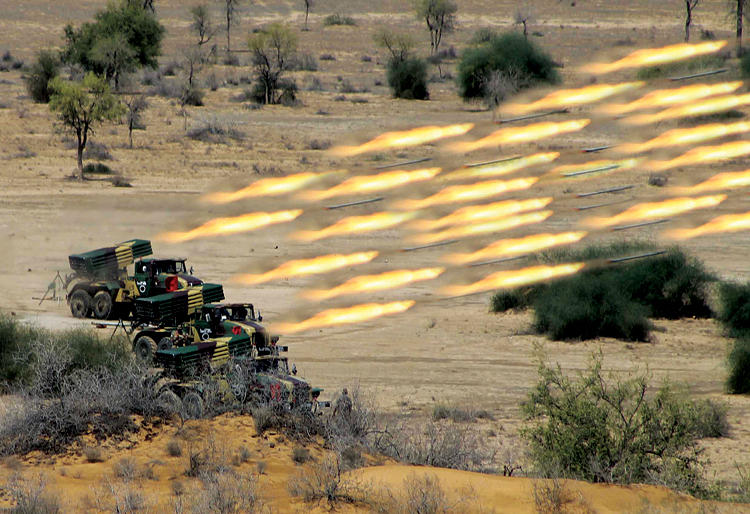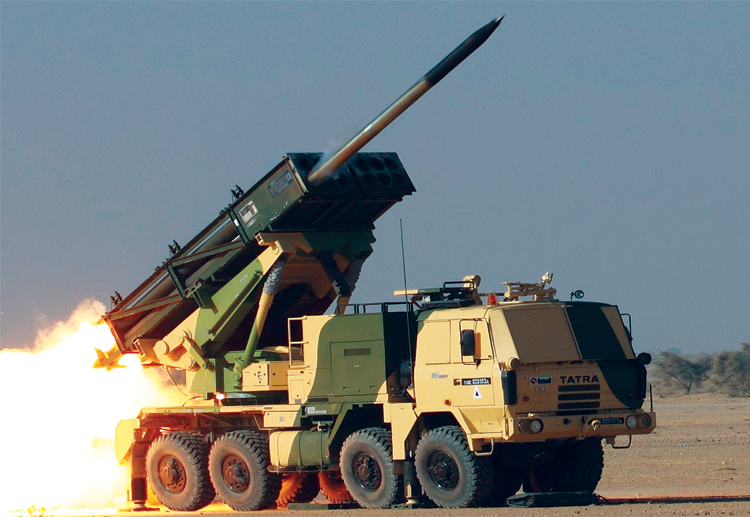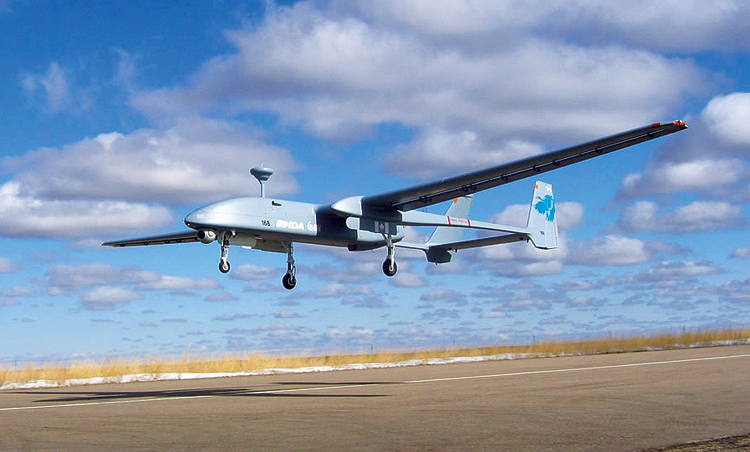INDIAN ARMED FORCES CHIEFS ON
OUR RELENTLESS AND FOCUSED PUBLISHING EFFORTS

SP Guide Publications puts forth a well compiled articulation of issues, pursuits and accomplishments of the Indian Army, over the years

I am confident that SP Guide Publications would continue to inform, inspire and influence.

My compliments to SP Guide Publications for informative and credible reportage on contemporary aerospace issues over the past six decades.
- Interim Defence Budget 2024-25 — An Analysis
- Union Defence budget 2024
- Indian Army: In quest of greater firepower and policy recommendations for gaps
- Indian Army Annual Press Conference 2024
- 6G will transform military-industrial applications
- Tata Boeing Aerospace Delivers 250 AH-64 Apache Fuselages, Manufactured in India
Artillery in Battle Combat Capability - An Analysis
Capability building and modernisation is an ongoing process but the challenge is to carry out the assigned mission with the existing resources

Primary Role of Artillery
In Offensive Operations. Offensive operations involve attack by own infantry on the defensive positions held by the enemy. During attack, artillery fire can cause attrition, destroy/soften the target and also prevent direct fire on attacking troops from the enemy by keeping their heads down. It can also prevent enemy’s artillery to fire by engaging them with own artillery called counter bombardment. Artillery fire can prevent reinforcements from coming to the aid of their own troops by isolating the target area by fire. It can also carry out sporadic fire to harass the enemy, prevent them from resting or keep them guessing of the place and time of attack. Similar support is given to mechanised infantry while carrying out offensive operations. Armour is also supported during offensive operations specially when carried out through wooded area, urban/semi urban area and where crops are still standing to prevent accurate anti-tank fire.
In Defensive Operations. Defensive positions are normally held by infantry and likely routes/approach of attack are analysed and identified as Defensive Fire (DF) targets whose firing data (ballistic data) is pre-registered and recorded. A large number of DF targets are recorded to cater for every contingency. Correction for weather conditions like atmospheric pressure and wind direction is applied periodically so that fire is accurate. As soon as a particular sector comes under attack, fire can be called for on the DF targets in that area. The spread of the artillery fire will be effective against moving targets and cause heavy casualties to the troops in the open. Opportunity targets can also be easily neutralised.
Terrain
Regiment of Artillery is equipped and trained to operate and fight in all type of terrains like plains, desert, semi desert, high altitude including Siachen.
Scaling of Artillery
Integral artillery is scaled at the level of a division with each of them having one artillery brigade. Similarly at corps level there are suitably equipped independent artillery brigades which provide reinforcing artillery to the divisions when required. Above the corps there are a few artillery divisions scaled as per the operational requirement. The aim of artillery is to provide such over whelming destruction through fire power that own infantry/mechanised infantry and armour suffer minimum casualties during operations.
Type of Armament held by Artillery
The Regiment of artillery holds a variety of guns, mortars, rocket launchers, missiles, unmanned aerial vehicles and surveillance systems to carry out their role. Brief details are:
Guns. Artillery’s arsenal consists of a variety of guns of various calibre like the indigenous 105mm Indian Field Gun (IFG) with range of about 17 km, 105mm Light Field Gun which is similar to IFG but lighter in weight thus most suitable for the mountains or a terrain where mobility problems exist. They were extensively used in Kargil to provide suppressive fire support to own infantry attacking Pakistan defences. In the heavier caliber there is 130 mm M46 with a range of about 27km, 155 mm FH-77B with a range of about 24 to 30km and upgraded M46 guns to 45 calibre where the range can go upto 39000m, depanding upon the projectile. In the self propelled category there is 130 Catapult which has been indigenously integrated by mounting the ordnance of the M-46 atop a Vijayanta tank chassis. Earlier Abbot of British origin was in service which has been phased out.
Mortars. Mortars are ideal for firing in the mountains, on troops in the open or in open trenches. Artillery holds 120mm calibere mortars with a range of about 5 to 9 km.

Rocket artillery. India has a formidable arsenal in rocket artillery and their effect on the target end is devastating and demoralising for the enemy. The oldest is 122mm BM-21 Grad Multiple Barrel Rocket Launcher with 40 rockets on each launcher and a range between 11 to 20 km. The place of pride is 214mm Pinaka multi-barrel rocket launcher which has been developed indigenously. Pinaka is named after the bow of Lord Shiva. It carries 12 rockets per launcher with a range of 10 to 38 km. The firing sequence is programmable from 4-200sec. The third multi-barrel rocket launcher is 300mm BM-30 Smerch multiple barrel rocket launcher of Russian origin which carries 12 rockets per launcher with a range of about 20 to 70 km.
Surface to surface Prithvi-I Missile System. The Surface-to-Surface Missile Privthi was developed under the Integrated Guided Missile Development Programme (IGMDP) and first test-fired on February 25, 1988.It is reported to have a single-stage liquid fuel dual motor with a range of 150 km with a payload of 1,000 kg and is in service with artillery. Other versions are meant for the Navy and the Air Force. Prithvi is likely to be replaced by Prahar which is more accurate and under development.
Agni Missile. The Agni missile is a family of medium to intercontinental range ballistic missiles (MRBM/ICBM) developed by India under the IGMDP and tested in 1989. After the development of Agni, due to its importance, Agni Missile programme was delinked from IGMDP and is being developed separately. The MRBM version of Agni is with the Army. Reported range of the MRBM version varies from 700-3000km.

BrahMos Cruise Missile. BrahMos is a supersonic cruise missile, development of which started in the 1990s as a joint project between Russia and India to develop an Indian version of the P-800 Oniks cruise missile. The missile’s name is a portmanteau of the rivers Brahmaputra and Moskva. Advantages of BrahMos over a subsonic missile are: it is three times faster, 2.5-3 times more range, 3-4 times more seeker range and 9 times more of kinetic energy. It has reported range of 290 km and has a separate version for the Navy and the Air Force. The land version has been service since 2007.
The capability of the Regiment of Artillery can be judged from its performance during combat. It has performed with dedication and valour in every conflict since Independence
Reconnaissance, Surveillance and Target Acquisition (RSTA)
Target acquisition is the detection, identification and location of a target to such a degree that it can be effectively neutralised or destroyed. This role is carried out by Surveillance and Target Acquisitions (SATA) units of the Artillery. They hold groundbased sensors like radars and other similar devices, which could be land based or air borne from a UAV platform. Brief details are:
- ANTPQ – 37 Firefinder. AN/TPQ-37 Firefinder is a mobile radar system manufactured by ThalesRaytheonSystems (formerly Hughes Aircraft, which was acquired by Raytheon). The system is a long-range version of weaponlocating radar, designed to detect and track incoming artillery and rocket fire to determine the point of origin for counter-battery fire. The AN/TPQ-37 is an electronically steered radar, implying that the radar does not actually move while in operation.
- Indigenous Weapon Locating Radar (WLR). This radar is developed by DRDO and manufactured by Bharat Electronics Limited. The WLR is a mobile artillery locating Phased array radar developed by India. This counter-battery radar is designed to detect and track incoming artillery and rocket fire to determine the point of origin for counter-battery fire.
- Israel Aerospace Industries Long Range Observation System (LOROS). LOROS is a multi-sensor imaging system for long-range day and night observation system. The system includes Highly gyro-stabilized turret with 4 sensors (Thermal imager, color charge-coupled device [CCD] zoom, B/W CCD spotter and intensified charge-coupled device [ICCD)] and laser range finder).

Airborne Workstations. Following are in service:
- Israel Aerospace Industries’ (IAI) Searcher UAV. Searcher is a multi mission tactical UAV which can carry out the role of surveillance, reconnaissance, target acquisition, artillery adjustment of fire and damage assessment. Searcher has been constantly improved from MkI to MkII and MkIII. The Searcher MkIII has multiple operational configurations, SAR/GMTI (Synthetic Aperture Radar/Ground Moving Target Indicator),SIGINT and EO/IR has a maximum altitude of >23000ft, and of endurance of 18h and mission radius is 350km.
- IAI’Heron. Heron 2 is the largest medium-altitude long-endurance UAV built in Israel with an operational altitude of 45,000 ft and is capable of missions of more than 36 hours duration. It provides deep-penetration, wide-area, real-time intelligence to national agencies, theatre commanders and lower echelons with primary role being intelligence, surveillance and target acquisition.
Capability building
Director General of Artillery, Lt General P.K. Srivastava has stated, in an recent interview with SP’s Land Forces, that the, “Rationalization Plan was first perceived in year 2000, wherein 155mm was made the standard gun system for Indian Artillery. Accordingly, ‘Artillery Profile’ was conceived and promulgated with emphasis on Mediumisation of Artillery. Since then, based on our operational necessity, concerted effort has resulted in successfully contracting of 155mm/39 Cal Ultra-Light Howitzers from US Government and 155mm/52 Cal Tracked (Self-Propelled) Artillery guns with L&T. To give impetus to indigenization major projects such as 155mm/45 Cal Dhanush Gun System, design and development by OFB and 155mm/52 Calibre Advance Towed Artillery Gun System (ATAGS) designed by DRDO in partnership with Private Industry, is also being pursued”. There are plans to acquire more modern RSTA systems and precision guided munitions. The Regiment of Artillery has decided to standardise the calibre of its guns at 155mm so as to ensure commonality of ammunition and smoother management of the inventory. Such a move will also unfurl a fire storm at the target end. Capability building and modernization is an ongoing process but the challenge is to carry out the assigned mission with existing resources. The capability of the Regiment of Artillery can be judged from its performance during combat. It has performed with dedication and valour in every conflict since Independence. During Kargil operations, the then COAS honoured three artillery regiments for exceptional and exemplary valour with unit citations. Combat capability is not only of the weapon systems but the soldiers who man them.
Regiment of Artillery has won many awards since Independence which include 7 Mahavir Chakras and 92 Vir Chakras amongst others which speaks highly of their combat capability. Their motto Sarvatra, Izzat-o-Iqbal (Everywhere with Honour and Glory) says it all.





